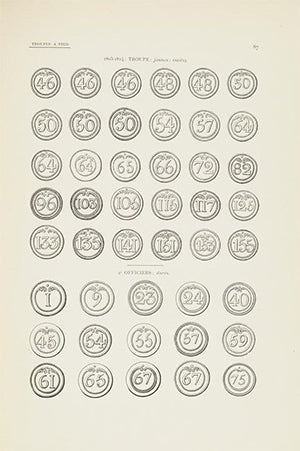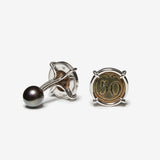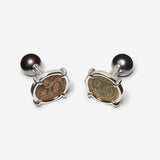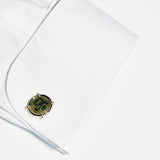BOUTONS ET BATAILLES CUFFLINKS
ORIGINAL ANTIQUITY
EARLY MODERN
We attend all our customers personally. Please leave us your contact details for information and sales.
We attend all our customers personally. Please leave us your contact details for information and sales.
DESCRIPTION
TWO ORIGINAL 1ST FRENCH EMPIRE UNIFORM BUTTONS, (1804-1815 AD) · Napoleon’s Grande Armée was organised in numbered regiments, each with their distinctive bronze buttons. We create your Boutons et Batailles cufflinks with the buttons/regiment number of your choice.
Our timeless design in 18k white gold provides clean contrast between the smooth black pearls and the unique bronze patina.
-
Available in button numbers (1-100)
-
18k white gold
-
Unique bronze patina
-
AA+ grade Tahitian pearls. Diameter 1.0cm/0.39”
Cufflinks diameter (incl. frame) 1.9cm/0.75”

TWO NAPOLEON'S 1ST EMPIRE UNIFORM BUTTONS (1804-1815 AD)
In 1804 Napoleon Bonaparte crowned himself as 1st Emperor of France, and organised his Grande Armée into 144 numbered regiments. Over a span of 10 years more than 2 million French villagers were conscripted to fight a large list of battles all over Europe. Our collection includes matched button pairs from the following numbers/regiments: 27, 32, 36, 50, 54, 58, 66, 69, 94.
We have the complete war records for each of the regiments. These specific buttons belonged to the infantry division of the 50th regiment that participated in the following battles and combats:
1805: Gunzburg, Elchingen, and Scharnitz
1806: Jena
1807: Waltersdorf and Guttstadt
1808: Tudela
1809: Tamames
1810: Cuidad-Rodrigo and Busaco
1811: Redhina, Casal-Novo, Foz-do-Arouce
1812: Salamanca
1813: Nivelle and Bayonne
1813: Lutzen, Bautzen, Leipzig, and Hanau
1814: Gue-a-Tresmes and Fere-Champenois
1815: Ligny and Wavre
French historic uniform buttons have been extensively documented by Louis Fallou in his book “Le bouton uniforme français”.


-
E. Diderot, Encyclopédie, tome 2 “bouton”, tome 2 “bataille”
-
E. M. de Lyden, Nos 144 Régiments de ligne
-
L. Fallou, Le bouton d’uniforme français
-
J. Croyet, Paroles de Grognards (1792–1815). Lettres inédites de la Grande Armée
-
J. Op De Beeck, Napoleon
We have been collecting flat uniform buttons from the 1st Empire from a number of antiques and ancient coin dealers in Spain and France. The buttons have been mainly selected on patina and state of conservation. We have recovered extensive background info for each of the specific regiments, including all battle history.
-
Pyramids (1798 AD)
-
Austerlitz (1805 AD)
-
Jena (1806 AD)
-
Friedland (1807 AD)
-
Wagram (1809 AD)
-
Waterloo (1815 AD)
BOUTONS ET BATAILLES
In 1715, the death of the Sun King Louis XIV marked the beginning of the Age of Enlightenment. New, elevated ideals of reason, tolerance and fraternity augured a new world of liberty and happiness for the people. A hundred years later, Napoleon’s 1815 defeat in Waterloo ended the most deadly streak of revolution and wars that Europe had ever seen. This is a story of buttons and battles. It is a tale that starts with the pen of an enlightened thinker, and ends on the European battlefields of Napoleon’s Grande Armée.
Denis Diderot was one of the great thinkers of the Enlightenment. Published from 1751, his Encyclopédie was a collective effort to incorporate all the world’s knowledge, from politics and philosophy to mechanical arts. It was meant to extend new ideas from the Paris salons to a broader, provincial public. One of the 7.000 entries written by Diderot himself was about the art of making buttons. Beautifully illustrated, it blurred the boundaries between craft and art.

Fifty years later, in 1804, Napoleon Bonaparte crowned himself as 1st Emperor of France. The same year he organized La Grande Armée in 144 numbered regiments. Millions of French provincial boys were drafted into servicing the freedom of the people on far away battlefields. Rather than symbols for liberty and happiness, their numbered uniforms became synonymous with the spread of destruction from Madrid to Moscow.
Diderot died 5 years before the French revolution. Surely he did not intend such a direct connection between the entries of bouton and bataille in his life’s work. History has a way of corrupting elevated new ideas before they radically change the world. Darwin’s “survival of the fittest” was twisted by Hitler into a sordid “extermination of the weak',' before it led to modern day genetics.
The hundred years from Louis 14’s Versailles to Napoleon’s Waterloo marked a period of transition, eventually shaping society into what it is today. The numbered buttons of Napoleon’s 1st Empire are a testament to how new ideas eventually overcome their turbulent beginnings.










